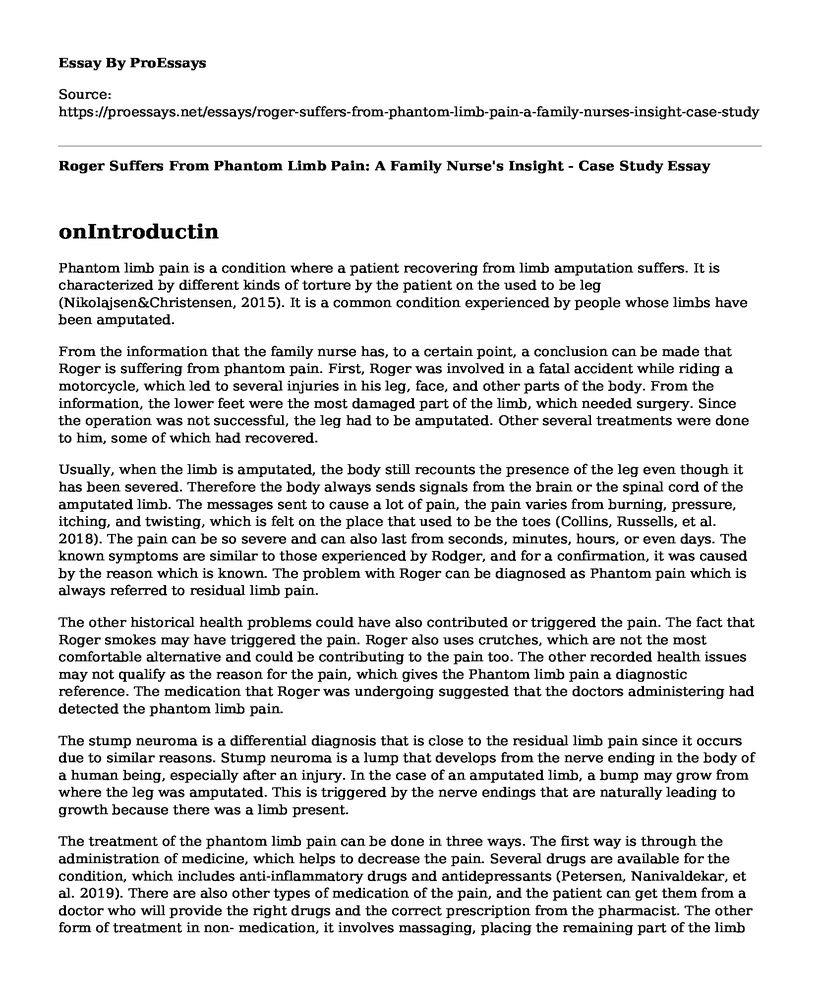onIntroductin
Phantom limb pain is a condition where a patient recovering from limb amputation suffers. It is characterized by different kinds of torture by the patient on the used to be leg (Nikolajsen&Christensen, 2015). It is a common condition experienced by people whose limbs have been amputated.
From the information that the family nurse has, to a certain point, a conclusion can be made that Roger is suffering from phantom pain. First, Roger was involved in a fatal accident while riding a motorcycle, which led to several injuries in his leg, face, and other parts of the body. From the information, the lower feet were the most damaged part of the limb, which needed surgery. Since the operation was not successful, the leg had to be amputated. Other several treatments were done to him, some of which had recovered.
Usually, when the limb is amputated, the body still recounts the presence of the leg even though it has been severed. Therefore the body always sends signals from the brain or the spinal cord of the amputated limb. The messages sent to cause a lot of pain, the pain varies from burning, pressure, itching, and twisting, which is felt on the place that used to be the toes (Collins, Russells, et al. 2018). The pain can be so severe and can also last from seconds, minutes, hours, or even days. The known symptoms are similar to those experienced by Rodger, and for a confirmation, it was caused by the reason which is known. The problem with Roger can be diagnosed as Phantom pain which is always referred to residual limb pain.
The other historical health problems could have also contributed or triggered the pain. The fact that Roger smokes may have triggered the pain. Roger also uses crutches, which are not the most comfortable alternative and could be contributing to the pain too. The other recorded health issues may not qualify as the reason for the pain, which gives the Phantom limb pain a diagnostic reference. The medication that Roger was undergoing suggested that the doctors administering had detected the phantom limb pain.
The stump neuroma is a differential diagnosis that is close to the residual limb pain since it occurs due to similar reasons. Stump neuroma is a lump that develops from the nerve ending in the body of a human being, especially after an injury. In the case of an amputated limb, a bump may grow from where the leg was amputated. This is triggered by the nerve endings that are naturally leading to growth because there was a limb present.
The treatment of the phantom limb pain can be done in three ways. The first way is through the administration of medicine, which helps to decrease the pain. Several drugs are available for the condition, which includes anti-inflammatory drugs and antidepressants (Petersen, Nanivaldekar, et al. 2019). There are also other types of medication of the pain, and the patient can get them from a doctor who will provide the right drugs and the correct prescription from the pharmacist. The other form of treatment in non- medication, it involves massaging, placing the remaining part of the limb in an appropriate position and use of therapies like the mirror box therapy. For proper treatment, the patient will need the guidelines of a physician, which includes return guidelines. The return guidelines would be the number of days when the patient will need to go for checkups, medication, and therapies, if any.
References
Nikolajsen, L., & Christensen, K. F. (2015). Phantom limb pain. In Nerves and Nerve Injuries (pp. 23-34). Academic Press.
Collins, K. L., Russell, H. G., Schumacher, P. J., Robinson-Freeman, K. E., O'Connor, E. C., Gibney, K. D., ... & Tsao, J. W. (2018). A review of current theories and treatments for phantom limb pain. The Journal of clinical investigation, 128(6), 2168-2176.
Petersen, B. A., Nanivadekar, A. C., Chandrasekaran, S., & Fisher, L. E. (2019). Phantom limb pain: peripheral neuromodulatory and neuroprosthetic approaches to treatment. Muscle & nerve, 59(2), 154-167.
Cite this page
Roger Suffers From Phantom Limb Pain: A Family Nurse's Insight - Case Study. (2023, Mar 13). Retrieved from https://proessays.net/essays/roger-suffers-from-phantom-limb-pain-a-family-nurses-insight-case-study
If you are the original author of this essay and no longer wish to have it published on the ProEssays website, please click below to request its removal:
- Health Program Planning and Evaluation Paper Example
- Team-Based Healthcare: Benefits & Challenges - Essay Sample
- Essay Example on Jean Watson's Caring Theory: Enhancing Healing and Satisfaction
- Essay on Nurse With Practice/Research Doctorate: Clinical Practice + Research Leadership
- Research Paper on Child Mortality: A Global Crisis Affecting 6 Million Children
- EHRs vs Survey Data in Health Care: Quality Measurements - Essay Sample
- Essay Sample on Modern Healthcare: CEOs Facing Strict Measures to Meet Medical Demands







